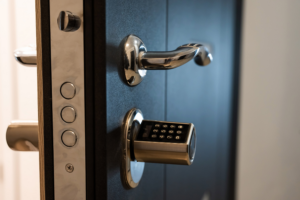Having a broken key stuck in a padlock or gate is more common than you might think. A key can break for several reasons, including wear and tear, improper insertion, or even a poorly maintained lock. No matter the cause, the frustration of being locked out due to a broken key can be overwhelming. Fortunately, removing a broken key doesn’t have to be a daunting task. In this guide, we’ll show you how to safely and effectively remove a broken key from your padlock or gate using the right techniques and tools.
Why Do Keys Break in Locks?
Understanding why keys break can help you prevent future issues with your locks. There are a few common reasons keys break inside locks, and knowing them will help you take the right steps to avoid it.
1. Worn-out Keys
Over time, repeated use can cause a key to lose its sharpness and strength. As the metal wears down, the key becomes more brittle and more prone to breaking, especially when it’s turned forcefully or used under pressure.
2. Forced Insertion
Inserting a key the wrong way, or forcing it into the lock when it’s misaligned, can stress the key and cause it to snap. It’s always essential to make sure the key is correctly oriented in the lock before attempting to turn it.
3. Rust and Corrosion
Locks exposed to the elements, especially outdoor gates, are prone to rust. Rust and corrosion inside the lock can make turning the key harder, leading to stress and the eventual breakage of the key.
4. Poor Quality Locks and Keys
Inexpensive or poorly made locks and keys are more likely to break than higher-quality alternatives. If you frequently experience key breakage, it may be time to upgrade your locks or get a high-quality key made.
5. Debris Inside the Lock
Dirt, grime, or other debris that gets stuck inside the keyhole can prevent the key from fully inserting or turning smoothly, causing it to snap under pressure.
Knowing the root cause of a broken key can help you take proactive steps to avoid similar issues in the future.
Step-by-Step Guide: How to Remove a Broken Key from Your Padlock or Gate
Now that you understand why keys break, it’s time to focus on how to safely remove a broken key from your padlock or gate. Follow these steps carefully to avoid causing further damage to your lock.
Step 1: Assess the Situation
Before you begin, take a moment to assess how much of the key is stuck inside the lock. Is the key broken flush with the keyhole, or can you see part of it sticking out? If part of the key is visible, you’ll have an easier time removing it. If the key is fully inside, the task may require a more advanced method.
Step 2: Gather the Necessary Tools
You’ll need the right tools to remove a broken key without damaging your lock. Some tools you may need include:
- Needle Nose Pliers: These are great for gripping small objects, especially if part of the key is sticking out of the keyhole.
- Broken Key Extractor Tool: Specifically designed for removing broken keys, this tool can help pull out a key lodged deep inside the lock.
- Lubricant (WD-40): Lubricating the keyhole can help loosen the key and make it easier to remove.
- Tweezers: Useful for grabbing smaller key fragments that may be stuck deep inside the lock.
- Flathead Screwdriver: In some cases, a flathead screwdriver can be used to provide leverage to dislodge the key.
Having these tools on hand will ensure you have what you need for the job.
Step 3: Apply Lubricant
Spray a small amount of lubricant into the keyhole. If rust, dirt, or grime is causing the key to stick, the lubricant will loosen it up, making it easier to extract. Allow the lubricant to sit for a few minutes before proceeding to the next step.
Step 4: Attempt to Grip the Key
If part of the key is exposed, use needle nose pliers to gently grip the exposed portion of the broken key. Be careful not to apply too much force, as this could break the key further and make it harder to remove. Gently wiggle the pliers while pulling to loosen the key from the lock.
Step 5: Use a Broken Key Extractor Tool
If the key is flush with the lock and you can’t get a good grip with pliers or extractors, you’ll need a broken key extractor tool. This tool is specifically designed for the task and works by sliding into the keyway, grabbing the teeth of the broken key, and pulling it out.
Insert the extractor tool carefully into the lock, ensuring it catches the grooves of the broken key. Once it’s in place, gently twist the extractor tool while pulling it out. The key should come free with minimal effort.
Step 6: Use Tweezers for Small Pieces
If only a small fragment of the key is stuck, you may need tweezers to extract it. Insert the tweezers into the lock, carefully grab the small piece of the broken key, and gently pull it out. This method works best for tiny key fragments that are stuck deep inside the lock.
Step 7: Test the Lock
Once you’ve successfully removed the broken key, it’s important to test the lock to make sure everything is functioning properly. Insert the original key (or a replacement) to see if the lock turns smoothly. If it doesn’t, the lock may be damaged, or debris may still be inside. In that case, cleaning and lubricating the lock might be necessary.
Preventing Future Key Breakage
After removing the broken key, it’s important to take steps to prevent future issues. Here are some preventative measures to ensure your keys and locks remain in good working order:
- Maintain Your Locks Regularly: Regularly lubricate and clean your locks to prevent rust and debris buildup. A well-maintained lock is less likely to cause key breakage.
- Replace Worn-out Keys: If your key shows signs of wear, such as being bent or having a rough edge, replace it before it breaks inside the lock.
- Use the Right Key: Always use the correct key for the lock to avoid putting unnecessary strain on the key.
- Don’t Force the Key: If the key doesn’t turn easily, don’t force it. The problem may be inside the lock, and forcing the key could break it.
- Upgrade Your Locks: If you’ve been experiencing frequent key breakage, consider upgrading your locks and keys to higher-quality options that are more durable.
By following these tips, you can prolong the life of your keys and locks and prevent future key breakages.
When to Call a Professional Locksmith
If you’ve tried removing the broken key yourself but haven’t had any luck, or if the lock is damaged during the removal process, it’s time to call in a professional locksmith. Major Island Locksmith has the tools, expertise, and experience to safely and efficiently remove broken keys and repair damaged locks. Here are some reasons you should call a locksmith:
- Key is Deeply Stuck: If the key is broken deep inside the lock and you can’t reach it with pliers or extractors, a locksmith has specialized tools to retrieve the key.
- Damaged Lock: If the lock is jammed, damaged, or malfunctioning after key removal, a locksmith can repair or replace it.
- Multiple Key Breakages: If your keys continue to break in the same lock, it may be a sign that the lock itself is faulty or needs to be replaced.
A professional locksmith can provide a quick and hassle-free solution, so you don’t have to worry about further damaging the lock. We also offer emergency services for those times when you need immediate assistance with a broken key or lock issue. Whether it’s a residential or commercial property, our team is equipped to handle it all.
Table: Tools for Broken Key Removal
| Tool | Description | When to Use |
|---|---|---|
| Needle Nose Pliers | Small, precise pliers for gripping tiny objects | When part of the key is exposed and you need a good grip |
| Broken Key Extractor | A tool designed to remove broken keys from locks | When the key is stuck deep inside the lock or flush with the keyway |
| Flathead Screwdriver | A flat tool to provide leverage and pry out keys | When the key is stuck but has some movement |
| Tweezers | Small tools for grabbing tiny pieces of broken keys | For very small fragments of a broken key |
| Lubricant (WD-40) | A lubricant to reduce friction and loosen stuck keys | When the key is stuck due to rust or debris |
Contact Major Island Locksmith for Professional Assistance
If you’ve tried everything and still can’t remove the broken key, don’t hesitate to Call Us. We specialize in broken key removal and can quickly get your lock functioning properly again. Whether you need assistance during regular hours or in an emergency, our team is ready to help.
Contact Us Today
📞 Phone: 516-779-6698
📧 Email: info@majorislandlocksmith.com
Removing a broken key doesn’t have to be difficult if you follow the right steps and have the proper tools on hand. However, if you run into any issues or need professional assistance, Major Island Locksmith is just a phone call away to ensure your locks and keys stay in top condition.




